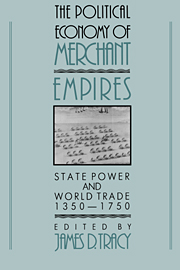Book contents
- Frontmatter
- Contents
- Acknowledgments
- Introduction
- 1 Institutions, Transaction Costs, and the Rise of Merchant Empires
- 2 Merchants and States
- 3 The Rise of Merchant Empires, 1400–1700: A European Counterpoint
- 4 Europe and the Wider World, 1500–1700: The Military Balance
- 5 The Pirate and the Emperor: Power and the Law on the Seas, 1450–1850
- 6 Transport Costs and Long-Range Trade, 1300–1800: Was There a European “Transport Revolution” in the Early Modern Era?
- 7 Transaction Costs: A Note on Merchant Credit and the Organization of Private Trade
- 8 Evolution of Empire: The Portuguese in the Indian Ocean During the Sixteenth Century
- 9 Comparing the Tokagawa Shogunate with Hapsburg Spain: Two Silver-Based Empires in a Global Setting
- 10 Colonies as Mercantile Investments: The Luso-Brazilian Empire, 1500–1808
- 11 Reflections on the Organizing Principle of Premodern Trade
- Selected Bibliography of Secondary Works
- Index
9 - Comparing the Tokagawa Shogunate with Hapsburg Spain: Two Silver-Based Empires in a Global Setting
Published online by Cambridge University Press: 25 March 2010
- Frontmatter
- Contents
- Acknowledgments
- Introduction
- 1 Institutions, Transaction Costs, and the Rise of Merchant Empires
- 2 Merchants and States
- 3 The Rise of Merchant Empires, 1400–1700: A European Counterpoint
- 4 Europe and the Wider World, 1500–1700: The Military Balance
- 5 The Pirate and the Emperor: Power and the Law on the Seas, 1450–1850
- 6 Transport Costs and Long-Range Trade, 1300–1800: Was There a European “Transport Revolution” in the Early Modern Era?
- 7 Transaction Costs: A Note on Merchant Credit and the Organization of Private Trade
- 8 Evolution of Empire: The Portuguese in the Indian Ocean During the Sixteenth Century
- 9 Comparing the Tokagawa Shogunate with Hapsburg Spain: Two Silver-Based Empires in a Global Setting
- 10 Colonies as Mercantile Investments: The Luso-Brazilian Empire, 1500–1808
- 11 Reflections on the Organizing Principle of Premodern Trade
- Selected Bibliography of Secondary Works
- Index
Summary
INTRODUCTION
In a recent article, two Japanese scholars point to the need for viewing sixteenth- and seventeenth century Japanese silver production in the context of a global market, concluding that “Japan's silver played an active, if supporting, role in the unfolding Price Revolution which the Western world experienced during the 16th century and the early decades of the 17th.” Data problems notwithstanding, there can be no doubt that immense quantities of silver were traded among all continents at that time. Silver (along with gold) must have been the first product in history traded across all oceans, seas, and continents simultaneously; it comprised the first global market in the emergence of a world economy. Spanish America was the largest source of silver in the world; it was the only area to outproduce Japan. American production is estimated by Attman at more than 300 metric tons per year during the seventeenth century, compared with Japanese production of at least 200 metric tons per year early in that century. The final destination of much of both areas' silver output was giant China, which contained roughly the same proportion of world population then as today. India was also a silver sink.
Spanish American silver took two general routes to China and India, the widely discussed Atlantic route (shipped from Vera Cruz and Puertobelo through Europe) and the largely ignored Pacific route (shipped out of Acapulco through Manila). Estimation of bullion flows out of the New World is difficult, however, because of a massive unreported contraband trade.
- Type
- Chapter
- Information
- The Political Economy of Merchant EmpiresState Power and World Trade, 1350–1750, pp. 332 - 359Publisher: Cambridge University PressPrint publication year: 1991
- 6
- Cited by



